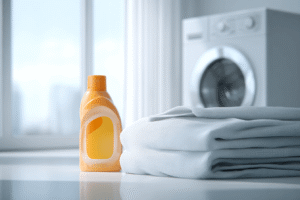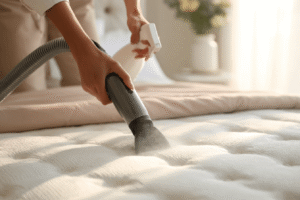Summarise this article with:
Waking up to blood stains on your bed sheets happens to the best of us. Whether it’s from a nosebleed, a small cut, or period blood, we know how frustrating it can be to face those stubborn stains. The good news? With the right techniques and quick action, you can save your sheets and get them looking fresh again.

Removing Blood Stains :
Remove Sheets Immediately
Strip your bed straight away – this prevents the blood from seeping through to your mattress protector or mattress itself. Time works against you here, so don’t delay.
Key immediate actions:
- Remove all affected bed linen from the mattress
- Check if blood has penetrated through to lower layers
- Keep stained areas separate from clean bedding
- Never put bloodstained sheets in your laundry basket with other clothes
Quick assessment tip: Hold the sheet up to check how far the stain has spread. Fresh blood appears bright red, while older stains turn brown. This helps determine your next course of action.
The faster you act, the better your chances of complete removal. We’ve seen too many perfectly good sheets ruined because someone waited until morning to deal with the stain.
Blot, Don’t Rub the Stain
The golden rule: Always blot, never rub when dealing with blood stains. Rubbing pushes blood deeper into fabric fibres and spreads the stain wider.
Proper blotting technique:
- Use a clean cloth soaked in cold water
- Press down gently and lift straight up
- Work from outside edges towards the centre
- Replace cloth sections as they absorb excess blood
| Blotting | Rubbing |
|---|---|
| Lifts blood from fibres | Pushes blood deeper |
| Contains the stain | Spreads stain outward |
| Preserves fabric integrity | Can damage delicate fibres |
What you need: Clean cloths, cold water, and patience. If you don’t have proper cloths handy, paper towels work perfectly fine. Keep dabbing until no more blood transfers to your cloth – this is your sign that you’ve removed all the surface blood possible.
Cold Water Treatment: Your First Line of Defence
Why Cold Water Works Best
Blood contains proteins that behave very differently depending on water temperature. Heat causes these proteins to coagulate and bind permanently to fabric fibres – think of how egg whites solidify when cooked.
Cold vs Hot Water Effects:
| Cold Water | Hot Water |
|---|---|
| Keeps proteins soluble | Causes protein coagulation |
| Allows blood to dissolve | Sets stains permanently |
| Preserves fabric integrity | Can damage delicate fibres |
Why cold water wins:
- Prevents protein binding – blood stays liquid and washable
- Dilutes blood effectively without chemical changes
- Protects your sheets from heat damage
The science is simple: cold water keeps blood in its natural liquid state, making removal straightforward. Hot water essentially “cooks” the blood into your sheets, creating a permanent bond that’s nearly impossible to break.
Pro tip: Use water that feels cool to touch – lukewarm water can still cause some protein setting.
Proper Rinsing Technique
Hold the stained area under cold running water and let the stream flow through the back of the fabric. This pushes blood outward rather than deeper into the fibres.
Step-by-step rinsing process:
- Position the sheet so water hits the underside of the stain
- Keep water pressure gentle but steady
- Rinse for 2-3 minutes until water runs clear
- Gently work the fabric between your fingers
| Right Way | Wrong Way |
|---|---|
| Water through back of stain | Direct water onto stain surface |
| Gentle finger movement | Aggressive scrubbing |
| 2-3 minutes minimum | Quick 30-second rinse |
What you’ll see: Fresh blood will dissolve immediately, creating pink-tinted water that gradually clears. If water stays clear from the start, you’ve successfully removed all surface blood.
Keep rinsing until absolutely no pink colour appears in the runoff water – this confirms you’ve extracted every trace of blood possible through rinsing alone.
Fresh Blood Stain Removal Methods
Hydrogen Peroxide Treatment
Grab that bottle from your medicine cabinet – hydrogen peroxide is your best way to tackle stubborn blood stains on white or light-coloured sheets.
Pour the solution directly onto the stain and watch it fizz. This bubbling reaction breaks down blood proteins, making removal effortless. Let it work for 10-15 minutes before gently dabbing with a clean cloth.
| Application Method | Best For |
|---|---|
| Direct application | Fresh stains |
| Baking soda mixture | Set-in stains |
What you’ll need:
- 3% hydrogen peroxide
- Clean cloths
- Old toothbrush for gentle scrubbing
Important: Always test on a hidden area first – hydrogen peroxide can bleach darker fabrics. For coloured sheets, try white vinegar or lemon juice instead.
The fizzing stops when the reaction completes, signalling you can rinse with cold water.
Salt Paste Application
Salt works brilliantly on delicate fabrics where stronger chemicals might cause damage. This gentle yet effective method breaks down blood proteins naturally.
Creating your salt paste:
- Mix 2 tablespoons of table salt with cold water
- Stir until you achieve a thick, spreadable consistency
- Apply generously to cover the entire stained area
Application process:
- Wet the stain with cold water first
- Spread paste evenly over the blood stain
- Let sit for 10-20 minutes for fresh stains
- Gently work the mixture with your fingers
| Fabric Type | Sitting Time |
|---|---|
| Cotton/Polyester | 15-20 minutes |
| Silk/Linen | 10 minutes maximum |
Rinse thoroughly with cold water until paste dissolves completely. The salt’s dehydrating properties lift blood from fibres without harsh scrubbing.
Dish Soap Solution
Every kitchen has this powerful stain-fighting ally sitting right beside your sink. Regular washing-up liquid contains surfactants that break down blood proteins effectively.
Creating your solution:
- 1 tablespoon liquid dish soap
- 2 tablespoons cold water
- Clean cloth for application
| Stain Age | Soaking Time |
|---|---|
| Fresh (under 1 hour) | 15-20 minutes |
| Semi-dried (1-4 hours) | 30 minutes |
Application method: Mix the soap and water in a small bowl. Apply directly to the stained area and gently work the solution into the fabric with your fingers. The soap lifts blood particles while remaining gentle on most fabric types.
Watch for results: The stain will gradually lighten as the solution penetrates. After soaking, rinse thoroughly with cold water and check your progress before washing normally.
How Do You Get Dried Blood Out of Sheets?
Extended Cold Water Soaking
When blood has dried and set into your sheets overnight, you need a more patient approach. This method works particularly well for stubborn stains that resist quick fixes.
The soaking process:
- Fill a basin with cold water only
- Submerge the entire stained area completely
- Weigh down with a clean plate if sheets float
| Stain Severity | Minimum Soaking Time |
|---|---|
| Light dried blood | 8-12 hours |
| Heavy set stains | 12-24 hours |
| Very old stains | 24+ hours |
Check progress every few hours – gently agitate the water and look for blood particles releasing from the fabric. Change the water if it becomes heavily discoloured.
The extended soaking allows dried blood proteins to gradually rehydrate and loosen their grip on fabric fibres, making subsequent treatments far more effective.
Best Stain Remover Products for Set Stains
Commercial stain removers pack serious punch when home remedies aren’t cutting through stubborn dried blood. These products contain specialised enzymes designed to break down protein-based stains effectively.
| Product Type | Best For | Fabric Safety |
|---|---|---|
| Vanish Oxi Action | White & coloured sheets | All washable fabrics |
| Carbona Stain Devils #4 | Dried blood specifically | Cotton, polyester blends |
| Hydrogen peroxide (3%) | Light-coloured bedding | Test on hidden area first |
Top performers include:
- Vanish Oxi Action – Creates satisfying foam reaction with blood
- Shout Advanced Gel – Concentrated formula with included brush
- OxiClean – Oxygen-based bleaching for tough stains
Application technique: Apply product directly to stain, work in gently, then leave for the recommended time before washing. These concentrated formulas often succeed where gentler methods fail.
Household Remedies That Actually Work
Baking Soda Paste Method
This household staple creates a gentle abrasive action that lifts dried blood without damaging your fabric fibres. Baking soda works particularly well on cotton and linen sheets.
Creating the perfect consistency:
- 2 parts baking soda
- 1 part cold water
- Mix until you achieve a spreadable paste
| Application Time | Stain Type |
|---|---|
| 30 minutes | Fresh stains |
| 1-2 hours | Set blood |
Spread the mixture generously over the entire stained area and work it gently into the fabric with your fingertips. The paste draws blood particles out as it dries, leaving behind easily removable residue that brushes away cleanly.
White Vinegar Solution
White vinegar sits in most kitchen cupboards yet many people overlook its brilliant stain-fighting abilities. The natural acidity breaks down blood proteins effectively, making this method perfect for both fresh and dried stains.
| Vinegar Strength | Best For | Mixing Ratio |
|---|---|---|
| Full strength | Fresh blood stains | 100% white vinegar |
| Diluted solution | Delicate fabrics | 1:1 vinegar to cold water |
Application method:
- Pour vinegar directly onto the stain
- Let it soak for 5-10 minutes
- Blot gently with a clean cloth
- Rinse thoroughly with cold water
The acid naturally loosens blood particles without harsh chemicals, making it safe for most fabric types. Repeat the process if traces remain before washing normally.
Washing Machine Guidelines for Blood Removal
Set your machine to the coldest available temperature – typically 30°C or below works best for blood stain removal. Hot water permanently sets protein stains into fabric fibres.
Choose the right wash cycle for your fabric type:
| Sheet Material | Recommended Cycle | Detergent Type |
|---|---|---|
| Cotton sheets | Normal/Heavy duty | Standard powder/liquid |
| Delicate fabrics | Gentle/Hand wash | Mild liquid detergent |
| Mixed materials | Synthetic cycle | All-purpose detergent |
Skip the fabric softener during blood stain removal – it creates a barrier that can trap remaining stain particles. Add oxygen bleach if your sheets can handle it safely.
Check sheets before drying – inspect carefully for any remaining traces. If blood persists, repeat the pre-treatment process rather than using heat, which makes future removal nearly impossible.
Special Considerations for Different Sheet Types
White Sheets and Bleach Options
White sheets give you the luxury of using stronger bleaching agents without worrying about colour damage or fading concerns.
| Bleach Type | Strength | Best Application |
|---|---|---|
| Chlorine bleach | Strongest | Stubborn, set stains |
| Oxygen bleach | Moderate | Regular maintenance |
| Fabric-safe bleach | Gentle | Delicate white fabrics |
Always dilute chlorine bleach properly – mix ¼ cup with ¾ cup cold water before applying directly to stains. This concentration provides maximum stain-fighting power while protecting fabric integrity.
Test on a hidden corner first, even with white sheets. Some treatments or fabric blends react unexpectedly to bleach solutions.
- Apply bleach solution only after pre-treating with cold water
- Never mix different bleach types together
- Rinse thoroughly before machine washing
Oxygen bleach offers a gentler alternative for regular blood stain removal on white cotton or linen sheets.
Coloured and Delicate Fabrics
Coloured sheets demand extra caution to prevent both stain setting and colour bleeding during blood removal treatments.
| Fabric Type | Safe Method | Avoid |
|---|---|---|
| Silk sheets | Salt water solution | Hydrogen peroxide |
| Bamboo fibres | Enzyme detergent | Chlorine bleach |
| Cotton blends | Mild dish soap | Hot water |
Test any treatment on a hidden seam first – even gentle solutions can cause unexpected colour changes on certain dyes. Apply your chosen method to an inconspicuous corner and wait 5 minutes before proceeding.
For delicate fabrics like silk or high thread count cotton, mix one teaspoon salt with one cup cold water. Dab this solution gently onto the stain and let it work for 10 minutes before rinsing thoroughly.
Prevention Tips to Avoid Future Stains
Smart prevention beats emergency cleaning every time – and we’ve learned this the hard way through countless customer experiences.
| Prevention Strategy | Effectiveness | Cost |
|---|---|---|
| Mattress protectors | High | Low |
| Dark-coloured sheets | Moderate | Low |
| Regular sheet rotation | High | Medium |
Keep backup sheets ready for quick changes during unexpected situations. Rotate between two sets weekly – this prevents emergency washing at inconvenient times.
Choose darker colours or patterns that naturally camouflage minor stains. Navy, burgundy, or patterned sheets hide small spots that white sheets broadcast immediately.
- Store emergency cleaning supplies in your bedroom
- Change sheets promptly after any incidents
- Invest in waterproof mattress protectors
- Consider washable bed pads for extra protection
Prevention saves both time and money – replacing stained sheets costs far more than protective measures.









